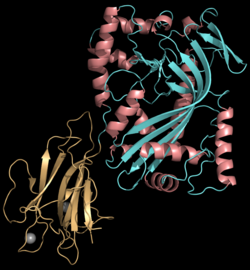穿孔素
穿孔素(英语:Perforin)是人体内一类由PRF1基因编码的蛋白质[2][3][4]。
| 穿孔素1 Perforin 1 | |||
|---|---|---|---|
 | |||
| 标识 | |||
| 代号 | PRF1; FLH2; HPLH2; P1; PFN1; PFP | ||
| 扩展标识 | 遗传学:170280 鼠基因:97551 同源基因:3698 ChEMBL: 5480 GeneCards: PRF1 Gene | ||
| RNA表达模式 | |||
 | |||
| 更多表达数据 | |||
| 直系同源体 | |||
| 物种 | 人类 | 小鼠 | |
| Entrez | 5551 | 18646 | |
| Ensembl | ENSG00000180644 | ENSMUSG00000037202 | |
| UniProt | P14222 | P10820 | |
| mRNA序列 | NM_001083116 | NM_011073 | |
| 蛋白序列 | NP_001076585 | NP_035203 | |
| 基因位置 |
Chr 10: 72.36 – 72.36 Mb |
Chr 10: 61.3 – 61.3 Mb | |
| PubMed查询 | [1] | [2] | |
功能
编辑穿孔素是一种由细胞毒性T细胞或自然杀伤细胞分泌的细胞溶解蛋白质。它们会插入靶细胞的细胞膜中,并形成孔隙。穿孔素的MACPF域能够促使细胞溶解[5]。该域与革兰氏阳性菌的胆固醇依赖性溶细胞素有一定的同源型[1]。
穿孔素在结构上和功能上与补体成分9(C9)具有一些共同点。比如说,穿孔素可以像补体成分9那样在细胞膜上形成能够非特异性地裂解多种靶细胞的孔洞。穿孔素是促细胞溶解颗粒中的一种主要促细胞裂解蛋白,在由T细胞和天然杀伤细胞介导的细胞溶解中起关键作用[4]。它通过在细胞膜上产生孔洞,从而让钙离子大量流入细胞,使得靶细胞启动细胞膜的修复机制。上述的修复机制可让穿孔素和颗粒酶进入早期内涵体[6]。
临床意义
编辑相互作用
编辑参见
编辑参考
编辑- ^ 1.0 1.1 Rosado CJ, Buckle AM, Law RH, Butcher RE, Kan WT, Bird CH, Ung K, Browne KA, Baran K, Bashtannyk-Puhalovich TA, Faux NG, Wong W, Porter CJ, Pike RN, Ellisdon AM, Pearce MC, Bottomley SP, Emsley J, Smith AI, Rossjohn J, Hartland EL, Voskoboinik I, Trapani JA, Bird PI, Dunstone MA, Whisstock JC. A common fold mediates vertebrate defense and bacterial attack. Science. 2007, 317 (5844): 1548–51. PMID 17717151. doi:10.1126/science.1144706.
- ^ Fink TM, Zimmer M, Weitz S, Tschopp J, Jenne DE, Lichter P. Human perforin (PRF1) maps to 10q22, a region that is syntenic with mouse chromosome 10. Genomics. Sep 1992, 13 (4): 1300–2. PMID 1505959. doi:10.1016/0888-7543(92)90050-3.
- ^ Shinkai Y, Yoshida MC, Maeda K, Kobata T, Maruyama K, Yodoi J, Yagita H, Okumura K. Molecular cloning and chromosomal assignment of a human perforin (PFP) gene. Immunogenetics. Jan 1990, 30 (6): 452–7. PMID 2592021. doi:10.1007/BF02421177.
- ^ 4.0 4.1 4.2 Entrez Gene: PRF1 perforin 1 (pore forming protein).
- ^ Tschopp J, Masson D, Stanley KK. Structural/functional similarity between proteins involved in complement- and cytotoxic T-lymphocyte-mediated cytolysis. Nature. 1986, 322 (6082): 831–4. PMID 2427956. doi:10.1038/322831a0.
- ^ Thiery J, Keefe D, Boulant S, Boucrot E, Walch M, Martinvalet D, Goping IS, Bleackley RC, Kirchhausen T, Lieberman J. Perforin pores in the endosomal membrane trigger the release of endocytosed granzyme B into the cytosol of target cells. Nat. Immunol. 2011, 12 (8): 770–7. PMC 3140544 . PMID 21685908. doi:10.1038/ni.2050.
- ^ Andrin C, Pinkoski MJ, Burns K; et al. Interaction between a Ca2+-binding protein calreticulin and perforin, a component of the cytotoxic T-cell granules. Biochemistry. July 1998, 37 (29): 10386–94. PMID 9671507. doi:10.1021/bi980595z.
拓展阅读
编辑- Trapani JA. Target cell apoptosis induced by cytotoxic T cells and natural killer cells involves synergy between the pore-forming protein, perforin, and the serine protease, granzyme B. Australian and New Zealand journal of medicine. 1996, 25 (6): 793–9. PMID 8770355. doi:10.1111/j.1445-5994.1995.tb02883.x.
- Peitsch MC, Amiguet P, Guy R; et al. Localization and molecular modelling of the membrane-inserted domain of the ninth component of human complement and perforin. Mol. Immunol. 1990, 27 (7): 589–602. PMID 2395434. doi:10.1016/0161-5890(90)90001-G.
- Young JD, Hengartner H, Podack ER, Cohn ZA. Purification and characterization of a cytolytic pore-forming protein from granules of cloned lymphocytes with natural killer activity. Cell. 1986, 44 (6): 849–59. PMID 2420467. doi:10.1016/0092-8674(86)90007-3.
- Young JD, Cohn ZA, Podack ER. The ninth component of complement and the pore-forming protein (perforin 1) from cytotoxic T cells: structural, immunological, and functional similarities. Science. 1986, 233 (4760): 184–90. PMID 2425429. doi:10.1126/science.2425429.
- Lichtenheld MG, Podack ER. Structure of the human perforin gene. A simple gene organization with interesting potential regulatory sequences. J. Immunol. 1990, 143 (12): 4267–74. PMID 2480391.
- Shinkai Y, Takio K, Okumura K. Homology of perforin to the ninth component of complement (C9). Nature. 1988, 334 (6182): 525–7. PMID 3261391. doi:10.1038/334525a0.
- Lichtenheld MG, Olsen KJ, Lu P; et al. Structure and function of human perforin. Nature. 1988, 335 (6189): 448–51. PMID 3419519. doi:10.1038/335448a0.
- Goebel WS, Schloemer RH, Brahmi Z. Target cell-induced perforin mRNA turnover in NK3.3 cells is mediated by multiple elements within the mRNA coding region. Mol. Immunol. 1996, 33 (4–5): 341–9. PMID 8676885. doi:10.1016/0161-5890(95)00155-7.
- Nöske K, Bilzer T, Planz O, Stitz L. Virus-Specific CD4+ T Cells Eliminate Borna Disease Virus from the Brain via Induction of Cytotoxic CD8+ T Cells. J. Virol. 1998, 72 (5): 4387–95. PMC 109669 . PMID 9557729.
- Andrin C, Pinkoski MJ, Burns K; et al. Interaction between a Ca2+-binding protein calreticulin and perforin, a component of the cytotoxic T-cell granules. Biochemistry. 1998, 37 (29): 10386–94. PMID 9671507. doi:10.1021/bi980595z.
- Yu CR, Ortaldo JR, Curiel RE; et al. Role of a STAT binding site in the regulation of the human perforin promoter. J. Immunol. 1999, 162 (5): 2785–90. PMID 10072525.
- Stepp SE, Dufourcq-Lagelouse R, Le Deist F; et al. Perforin gene defects in familial hemophagocytic lymphohistiocytosis. Science. 1999, 286 (5446): 1957–9. PMID 10583959. doi:10.1126/science.286.5446.1957.
- Takahashi T, Nieda M, Koezuka Y; et al. Analysis of human V alpha 24+ CD4+ NKT cells activated by alpha-glycosylceramide-pulsed monocyte-derived dendritic cells. J. Immunol. 2000, 164 (9): 4458–64. PMID 10779745. doi:10.4049/jimmunol.164.9.4458.
- Badovinac VP, Tvinnereim AR, Harty JT. Regulation of antigen-specific CD8+ T cell homeostasis by perforin and interferon-gamma. Science. 2000, 290 (5495): 1354–8. PMID 11082062. doi:10.1126/science.290.5495.1354.
- Göransdotter Ericson K, Fadeel B, Nilsson-Ardnor S; et al. Spectrum of Perforin Gene Mutations in Familial Hemophagocytic Lymphohistiocytosis. Am. J. Hum. Genet. 2001, 68 (3): 590–7. PMC 1274472 . PMID 11179007. doi:10.1086/318796.
- Clementi R, zur Stadt U, Savoldi G; et al. Six novel mutations in the PRF1 gene in children with haemophagocytic lymphohistiocytosis. J. Med. Genet. 2002, 38 (9): 643–6. PMC 1734943 . PMID 11565555. doi:10.1136/jmg.38.9.643.
- Ambach A, Bonnekoh B, Gollnick H. Perforin granule release from cytotoxic lymphocytes ex vivo is inhibited by ciclosporin but not by methotrexate. Skin Pharmacol. Appl. Skin Physiol. 2001, 14 (5): 249–60. PMID 11586066. doi:10.1159/000056355.